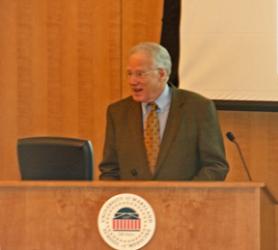Nanomedicine Conference Helps ‘Break Down Silos’ in Research
Variety of Researchers Share Insights into Medicinal Uses of Tiny Particles.

By Jeffrey Raymond
April 18, 2007
Nanomedicine isn’t just changing the future of health care, it is changing the way researchers collaborate to advance their work faster toward implementation.
Nanomedicine Research Day at the University of Maryland, Baltimore on March 23 offered scientists a chance to see some of the latest developments in nanomedicine research in the state, and to take away ideas for their own research. The discussions among presenters and the nearly 100 scientists in the audience that took place during and after the daylong event, hosted by the School of Pharmacy’s Center for Nanomedicine and Cellular Delivery (CNCD), were precisely what its organizers hoped to achieve.
“All the ingredients are here to propel Maryland to a leadership position” in the field, said University President David J. Ramsay, DM, DPhil.
Some of the challenges facing the industry – from the unknown consequences of having nanoparticles in the human body for extended periods to regulatory and liability issues, even environmental concerns – were also discussed.
Too often, conference organizers say, research isn’t as effective as it could be in addressing issues because the people doing the work don’t communicate with colleagues in other fields. The result is a “silo” effect in which research in particular fields accumulates, but doesn’t get shared or integrated across other fields. Nanomedicine – the science of using microscopic particles for diagnostics, targeted therapies and drug delivery, among other things – can work only if researchers in fields as varied as materials engineering, chemistry, biology, pharmacy, and medicine all work together.
The CNCD, recently designated a campus Organized Research Center by the President, comprises researchers in different schools at UMB and different universities in the state, and even extends to private companies working to bring developments in nanomedicine to the market. Ramsay, in a brief address at the opening of the conference, said his strategy in approving the CNCD was to “try to get out of the way as much as you can, and try to break down silos.”
William E. Kirwan, PhD, chancellor of the University System of Maryland and another keynote speaker at the event, said that not only does nanomedicine have “potential for revolutionary advances in medicine,” but it “can be one of the biggest science-based economic development engines.”
Only a few countries have the capability to develop this emerging technology, he said, and the Baltimore/Washington corridor, with its concentration of federal agencies, academic research centers and research parks for private companies, has “an unfair advantage” in becoming a hub for the industry. “Partnerships like this,” Kirwan told the Nanomedicine Research Day participants, “will be key to building our region into the powerhouse in nanomedicine research.”
Robert McGlotten, assistant secretary in the Maryland Department of Business and Economic Development, echoed the chancellor’s call to make the state a leader in the industry. He said the state’s priorities include creating an executive-level life sciences advisory board and expanding the bioscience research and development tax credit.
